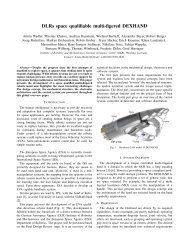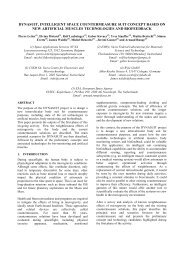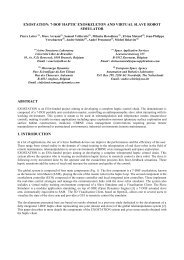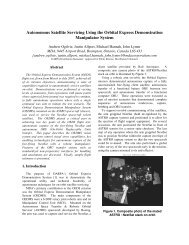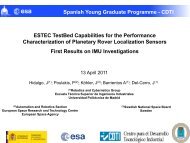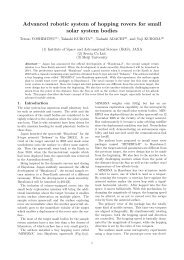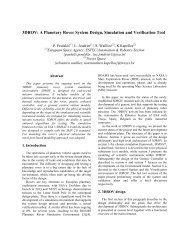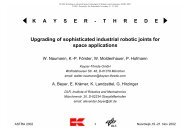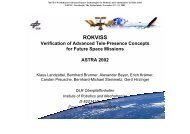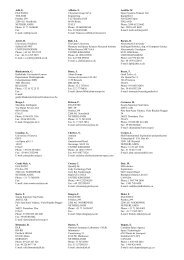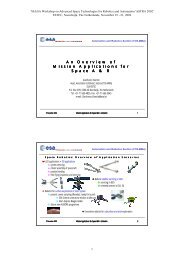EXOFLY: A FLAPPING WINGED AEROBOT FOR ... - Robotics - ESA
EXOFLY: A FLAPPING WINGED AEROBOT FOR ... - Robotics - ESA
EXOFLY: A FLAPPING WINGED AEROBOT FOR ... - Robotics - ESA
Create successful ePaper yourself
Turn your PDF publications into a flip-book with our unique Google optimized e-Paper software.
case of ExoFly failure. Impingement on rover instrumentation or mobility by a failed ExoFly deployment must be<br />
avoided, for instance. Strategies considered focus on ensuring failures occur at a distance from the rover, including<br />
impulsive ejection of inert ExoFly from the rover and movement of rover away from deployed inert ExoFlies before<br />
activation and takeoff.<br />
Further Redesign Issues<br />
While the DelFly already has considerable capability in the terrestrial environment, significant development is required<br />
for remote use on Mars. Considering primarily the baseline architecture described above, the following critical issues<br />
may be described.<br />
Power generation and storage is challenging, firstly in terms of the low temperature environment to be mitigated. Low<br />
mass is critical to feasibility of the locomotion of the vehicle, such that strategies used by conventional rovers such as<br />
insulation and active heating to protect the batteries may be unattractive for use in this case. While a penalty in terms of<br />
energy density would be incurred, use of supercapacitors for energy storage has been suggested due for resistance to the<br />
low temperatures to be encountered. In addition, recharging strategy of the batteries, with integration of solar cells into<br />
the tail, must be considered.<br />
While some autonomous control has already been implemented to augment direct human control of the DelFly<br />
demonstrators, complete flight, landing and takeoff autonomy is ongoing. In addition, it is likely that at least basic<br />
autonomy will be required onboard the ExoFly, rather than on the rover, to account for periods out of line-of-sight of<br />
the rover and to reduce communications requirements between the two.<br />
Localisation of the ExoFly will be critical to the usefulness of scientific observations if they are to be used in synergy<br />
with those of the rover. Vision based navigation based on recorded images are being considered for use as a navigation<br />
strategy but potential feasibility for differing mission types and accuracy are still to be fully assessed.<br />
Materials and parts used currently are commercially available and therefore suitability for use in space must be<br />
considered, with replacement if necessary. Lubrication of joints has also been identified as a challenging issue. For<br />
example, lubricants on the current Spirit and Opportunity rovers require active heating to retain adequate<br />
characteristics. A miniaturised magnetometer that may be further developed for use onboard ExoFly has already been<br />
identified [11].<br />
The relatively high frequency motor used to drive the wings has been identified as potentially causing interference to<br />
subsystems and payload, in particular the potential magnetometer payload and camera. As before, on this lightweight<br />
system opportunities for electromagnetic shielding or other direct methods of mitigation will be limited. Furthermore,<br />
flapping motion introduces instability to the images produced by the onboard camera. The impact of this source of error<br />
must be assessed for both visual navigation and scientific imaging. Mitigation strategies might include correction of<br />
images in software or implementation of error tolerant navigation.<br />
Exposure to the Mars environment must be mitigated with enhanced robustness and operation in the outside<br />
environment must be considered carefully. The current DelFly prototypes are relatively fragile and require frequent<br />
small repairs to function. Outdoor tests have been performed successfully but the system is highly sensitive to wind.<br />
Mitigation strategies might include operation only when in low wind conditions, or scheduling flights when wind is in<br />
the desired direction of motion. The ExoFly will also be vulnerable to high winds when on the ground. Possible<br />
mitigation may involve landing only in sheltered areas or integration of an anchoring system.<br />
Further aerodynamic study and optimisation for the Mars environment of the wings must be performed in terms of<br />
shape, materials, configuration and flapping motion. Tests are planned using environmental chambers at the University<br />
of Wageningen.<br />
It will be desirable for the system to be deployable to minimise stowed volume although this will introduce additional<br />
failure points and complexity into the design, as well as a requirement for some kind of actuation for deployment.<br />
Stowed configurations will likely involve folding of the wings.<br />
In summary, as yet no showstopping issues have yet been identified in use of the ExoFly concept as part of a Mars<br />
exploration mission architecture. It has been proposed that development of this technology may play an important role



